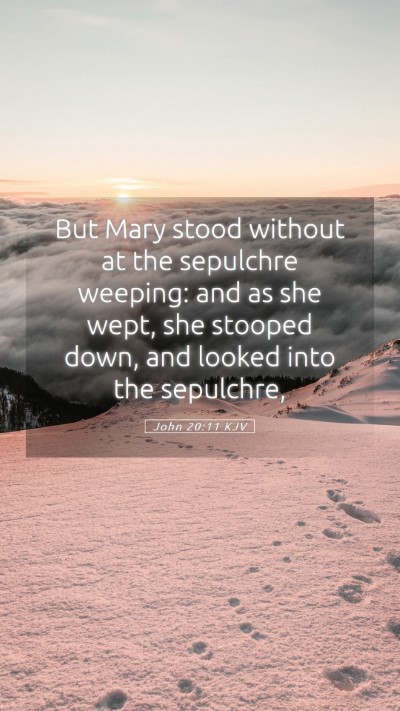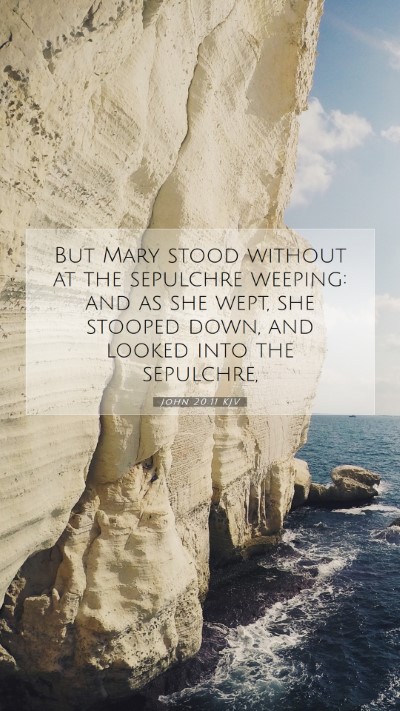Understanding John 20:11
John 20:11 states: "But Mary stood outside the tomb weeping; and as she wept, she stooped down and looked into the tomb."
Bible Verse Meanings
This verse describes a pivotal moment in the Gospel of John, showcasing Mary Magdalene's emotional state following the resurrection of Jesus. According to Matthew Henry, Mary’s grief illustrates the depths of her devotion and love for Jesus. Her standing outside the tomb signifies her desperation and confusion as a follower of Christ, a theme often reflected among disciples in the wake of His crucifixion.
Albert Barnes adds that Mary's weeping symbolizes the sorrow of loss and the struggle to comprehend the miraculous event that had just taken place. In her grief, she exemplifies the human experience of despair, which contrasts with the hope that the resurrection represents.
Adam Clarke highlights the importance of Mary’s actions—stooping to look into the tomb—which can signify an effort to seek understanding. Clarke emphasizes the necessity of seeking truth in moments of confusion and despair, a powerful message for all believers seeking clarity in troubling times.
Bible Verse Interpretations
The interpretation of this verse is enriched when analyzing its emotional weight. Mary’s actions can be viewed as a journey from despair to discovery. The weeping signifies her mourning, while the act of looking into the tomb symbolizes an attempt to grasp the reality of the resurrection. This searching mirrors the spiritual quest every believer undertakes in understanding Scripture and God’s promises.
Commentators note that Mary acts as a representative of humanity; her grief embodies the collective sorrow of those who loved Jesus and witnessed His suffering. This depiction invites readers into a space of empathy, as seen in many narratives throughout the Bible, where human emotion is a bridge to deeper spiritual truths.
Bible Verse Explanations
The circumstances surrounding this verse invite questions about the deeper significance of Mary’s perseverance in her search for Jesus. Why does she remain at the tomb? Her determination reflects a desire to connect with the lost loved one, an act of faith that resonates with many aspects of biblical teachings on love and loss.
This verse serves as a portal for understanding that grief, while painful, can lead to transformative experiences. Mary’s weeping manifests a form of worship, as it is born out of profound love for Christ. Barnes notes that this act of mourning is pivotal for understanding resurrection, as it defines the very human experience against the backdrop of divine love and salvation.
Applying Bible Verses to Daily Life
For those engaged in Bible study groups, this verse can initiate discussions on how grief impacts faith. How do we react in sorrow? Do we search for understanding as Mary did? This can lead to Bible study lessons surrounding emotional health, resilience in faith, and the power of seeking truth amidst despair.
Online Bible study forums could therefore benefit from exploring the dual narrative of human sorrow and divine promise present in this verse. Understanding this passage not only enhances individual study but also enriches group discussions about our response to loss and the hope offered through resurrection.
Historical Context of Bible Verses
To fully grasp the meanings embedded in John 20:11, one must consider its historical context. The immediate aftermath of Jesus' death was laden with uncertainty, fear, and despair among His followers. In this climate, Mary’s actions are not just filled with personal grief but reflect the collective trauma of Jesus’ disciples.
Applying historical context helps elucidate why Mary’s search is significant. Her decision to linger at the tomb demonstrates a profound commitment to understanding the events as they unfold, a stance that figures prominently in the discussions surrounding Bible study tools that focus on narrative techniques and emotional intelligence in Scripture.
Bible Cross References
- Luke 24:1-10: Provides another account of the women discovering the empty tomb.
- Matthew 28:1-10: Depicts the encounter of the women with the angel at the tomb.
- Mark 16:1-8: Highlights the moment they realize that Jesus has risen.
- John 20:14-17: Continues the narrative of Mary’s encounter with the risen Christ.
Conclusion
In summary, John 20:11 serves as a poignant reminder of the human experience of grief, coupled with a profound search for understanding. Through the combined insights of public domain commentaries, we gain a deeper appreciation for this verse’s implications regarding love, loss, and resurrection. Whether you are participating in a Bible study course or seeking personal insight, this verse offers a rich tapestry of emotions and theological significance that resonates deeply in the life of a believer.


